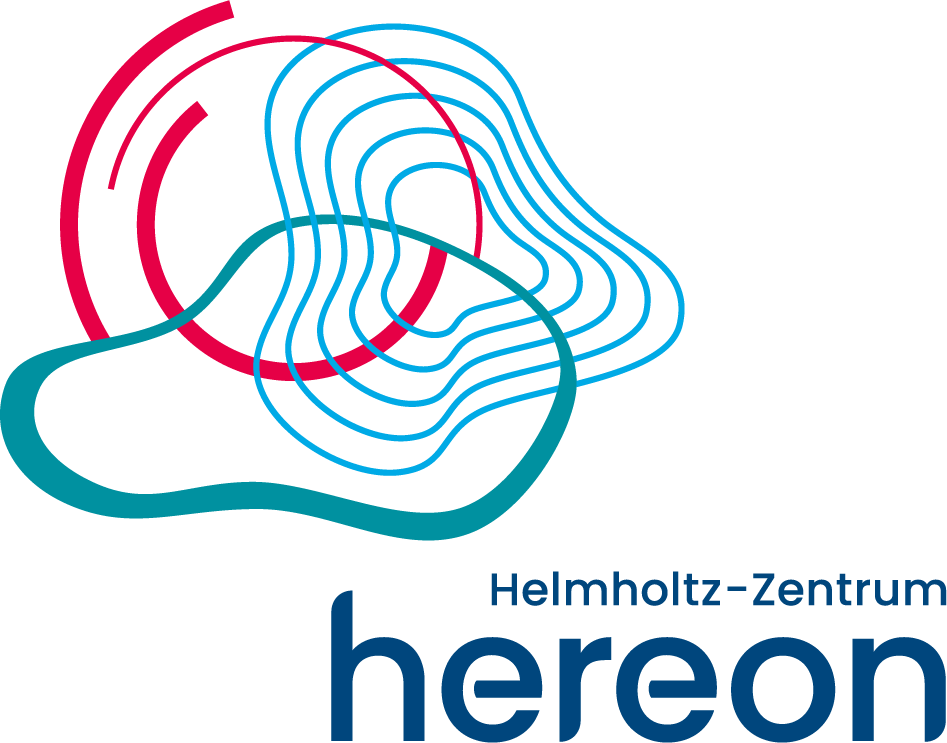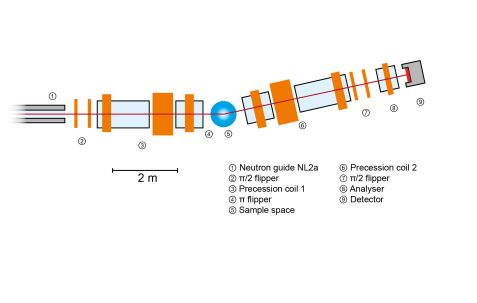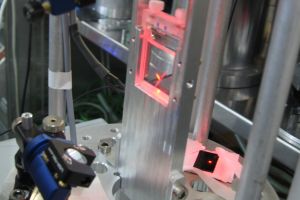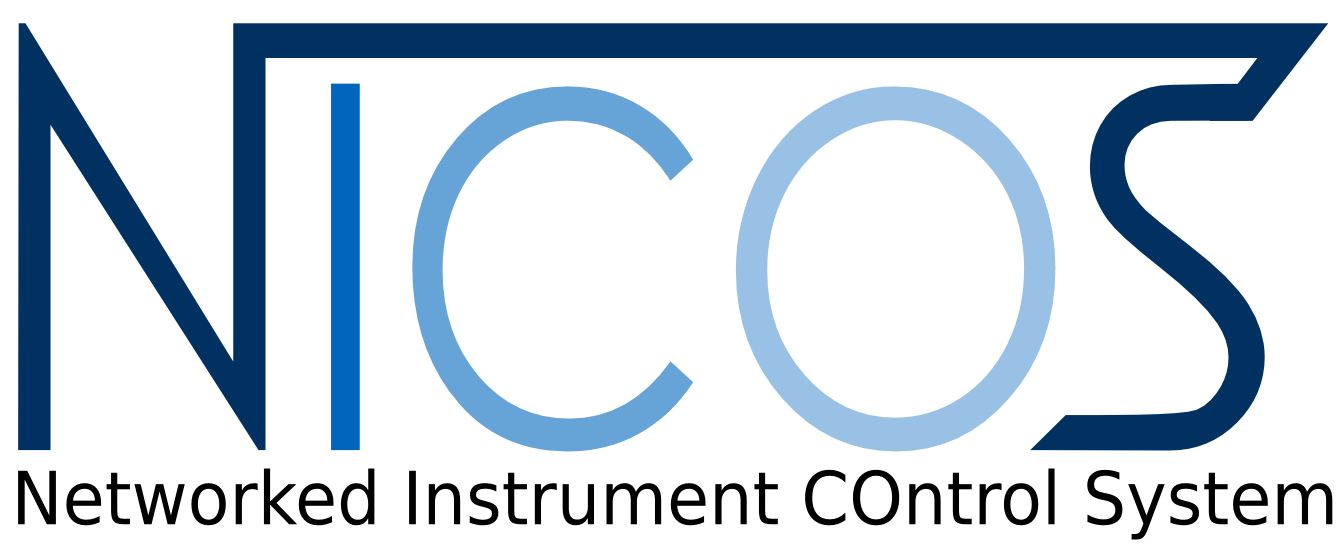MLZ is a cooperation between:
 > Technische Universität München
> Technische Universität München > Helmholtz-Zentrum Hereon
> Helmholtz-Zentrum Hereon
 > Forschungszentrum Jülich
> Forschungszentrum Jülich
MLZ is a member of:
 > LENS
> LENS > ERF-AISBL
> ERF-AISBL
MLZ on social media:

MLZ (eng)
Lichtenbergstr.1
85748 Garching
J-NSE ‘PHOENIX’
Neutron spin echo spectrometer

This instrument is focussed on cold neutrons. Therefore, please carefully check the “Technical data WITHOUT cold source” section. Deviating parameters are in bold. The instrument team is happy to answer any further questions!
The neutron spin echo technique uses the neutron spin as an indicator of the individual velocity change the neutron undergoes when scattered by the sample. Due to the usage of the spins as individual timekeepers for each neutron, the instrument accepts a broad wavelength band (incoming velocity spread) while at the same time maintaining sensitivity to the individual scattering-induced velocity changes down to 10-5. However, the information is carried by the spins as intensity modulation proportional to the cosine of a precession angle difference. Thus, the measured signal is the intermediate scattering function, i.e. the cosine transform S(Q,τ) of the scattering function S(Q, ω) for small velocity (i.e. energy) changes and a symmetric scattering function. All spin manipulations only serve to establish this special type of velocity analysis. [1]
Due to the intrinsic Fourier transform property of the NSE instrument, it is especially suited for the investigation of relaxation-type motions that contribute at least several percent to the entire scattering intensity at the momentum transfer of interest. In those cases, the Fourier transform property directly yields the desired relaxation function without numerical transformation and tedious resolution deconvolution. The resolution of the NSE may be corrected by a simple division.For a given wavelength the Fourier time range is limited to short times (about 2 ps for the J-NSE) by spin depolarisation due to the vanishing guide field and to long times by the maximum achievable field integral J. The time is proportional to J x λ3. The new superconducting main solenoids can create field integrals up to 1.5 Tm. Currently, the available correction scheme applied on the new optimised field shape coils allows “real-world” experiments with τ = 100 ns at λ = 8 Å corresponding to J = 1 Tm.
In a major upgrade in 2017 (J-NSE ‘PHOENIX’), the instrument was equipped with superconducting main precession coils which increased the achievable field integral by a factor of 3 compared to the previously used normal conducting copper coils. The field shape of the main solenoids has been optimised to guarantee the required field homogeneity of the different neutron paths passing through the instrument, thereby extending the regime with acceptable field integral homogeneity by a factor of 2.5 compared to the previous coils.
[1] F. Mezei (ed.), Neutron Spin Echo, Lecture Notes in Physics, Vol 128, Springer Verlag, Heidelberg (1980).
- Thermal fluctuations of surfactant membranes in microemulsions
- Polymer chain dynamics in melts
- Thermally activated domain motion in proteins, which is an important key for understanding the protein function
- Circulation thermostat furnace: 260 – 360 K
- Cryofurnace: 3 – 650 K
- Furnace: 300 – 510 K
- CO2-pressure cell: 500 Bar
Other specialised sample environments on request.
- Neutron guide NL2-a
- Polarisation:
- FeSi m = 5 single reflection polariser at the entrance of the spectrometer
- Cross-section of guide: 6 × 6 cm2
- Max. sample size: 3 × 3 cm2
- Collimation: By source and sample size 0.5° × 0.5°
- Polarised neutron flux at sample position (20% selector)
- 7 Å: 1 · 106 n cm-2 s-1
- Momentum transfer range: 0.02 – 1.8 Å-1
- Max. Fourier time range: 2 ps (4.5 Å) < τ < 70 ns (7 Å)
- Max. field integral: 1.2 Tm
- Recommended max. Fouriertime: 100 ns × (λ/8Å)2 for λ > 6 Å ; 45 ns × (λ/6 Å)3 λ < 6 Å
- Scattering angle: 2.50 < Φ < 85°
- 30 × 30 cm2 CoTi supermirror Venetian blind
- 32 × 32 1 cm² cells 3He multidetector
- Neutron guide NL2-a
- Polarisation:
- FeSi m = 5 single reflection polariser at entrance of the spectrometer
- Cross-section of guide: 6 × 6 cm2
- Max. sample size: 3 × 3 cm2
- Collimation: By source and sample size 0.5° × 0.5°
- Polarised neutron flux at sample position (20% selector)
- 7 Å: 1 · 106 n cm-2 s-1
- 12.9 Å: 1 · 106 n cm-2 s-1
- Momentum transfer range: 0.02 – 1.8 Å-1
- Max. Fourier time range: 2 ps (4.5 Å) < τ < 400 ns (12.9 Å)
- Max. field integral: 1.2 Tm
- Recommended max. Fourier time: 100 ns × (λ/8Å)2 for λ > 6 Å ; 45 ns × (λ/6 Å)3 λ < 6 Å
- Scattering angle: 2.50 < Φ < 85°
- 30 × 30 cm2 CoTi supermirror Venetian blind
- 32 × 32 1 cm² cells 3He multidetector
Instrument scientist
Dr. Olaf Holderer
Phone: +49 (0)89 158860-707
E-mail: o.holderer@fz-juelich.de
J-NSE
Phone: +49 (0)89 158860-506
Operated by

Funding

News
Publications
Find the latest publications regarding J-NSE in our publication database iMPULSE:
Citation templates for users
In all publications based on experiments on this instrument, you must provide some acknowledgements. To make your work easier, we have prepared all the necessary templates for you on this page.
Instrument control
Gallery

MLZ is a cooperation between:
 > Technische Universität München
> Technische Universität München > Helmholtz-Zentrum Hereon
> Helmholtz-Zentrum Hereon
 > Forschungszentrum Jülich
> Forschungszentrum Jülich
MLZ is a member of:
 > LENS
> LENS > ERF-AISBL
> ERF-AISBL
MLZ on social media:







